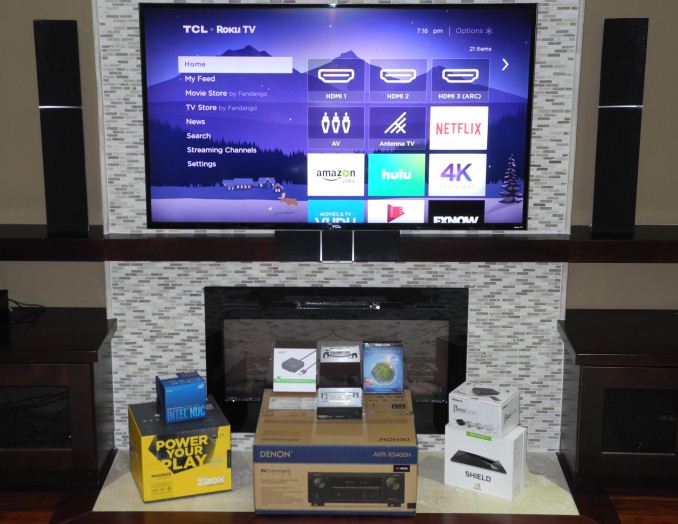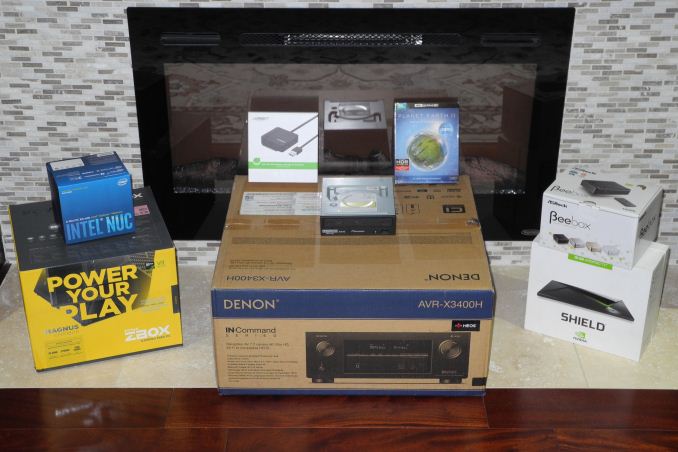A Budget Home Theater & PC Setup: 4K, HDR, UHD Blu-ray, and More
by Ganesh T S on December 26, 2017 8:30 AM EST
The days of bulky HTPCs with built-in optical drives, massive internal storage arrays, and integrated TV tuners are long gone. The advent of over the top (OTT) online streaming services has moved a lot of functionality to the cloud. As NAS units become more powerful, it has made sense to move local media files to a central repository. All these have enabled the TV-connected PC to become more compact. Unless the consumer has specific requirements (like, say, high quality gaming), even ultra-compact form factor (UCFF) machines such as the Intel NUCs can fit the bill.
Home Theater Components: Keeping up with the Times
The primary functionality of HTPCs has evolved to become one of a powerful and versatile media player. However, recent advances such as 4K and high dynamic range (HDR) videos, as well as stricter DRM requirements such as HDCP 2.2 for premium content have made the perfect HTPC platform difficult to achieve. Before delving deeper into these new advances, it is helpful to have some insight into how the landscape has changed over the last decade or so. The advancements in that timeframe have meant that next attractive home theater feature was always around the corner. In the initial days of 720p televisions and other home theater equipment, it was Full HD (1080p). As 1080p became widespread, it was HD audio bitstreaming. After that, 3D support was sought after. A brief lull ensued before the market started slowly getting ready for 4K.
Over the last year or so, we have seen the appearance of displays and audio/video receivers (AVRs) supporting HDMI 2.0 / HDCP 2.2 along with HDR / Dolby Vision. Despite the announcement of HDMI 2.1, I believe that we have reached a point where it is possible to purchase a relatively inexpensive home theater and HTPC configuration without worrying about it getting obsolete within the the next 3 to 5 years.
On the media side, OTT streaming services have become popular to the extent that Netflix and YouTube moved to offer 4K videos to consumers ahead of Blu-rays. Fortunately, many modern PCs are capable of 4K Netflix playback, though HDR is available only on a subset of those configurations. UHD Blu-ray playback support is available through CyberLink PowerDVD 17. However, the hardware requirements are a lot more specific compared to premium OTT services. UHD Blu-ray playback with HDR requires that the home theater components fulfill additional requirements.
Building a Home Theater on a Budget
I started work on this home theater piece back in June 2017. The aim was to present a setup (TV, AVR, and HTPC) with all the bells and whistles, yet light on the wallet. While the TV (TCL 55P607) and the AVR (Denon AVR X3400H) were easy to narrow down based on the feature requirements and budget, the PC side proved to be more challenging. Our core requirements (compact form factor, 4K Netflix support, and HDR capability) narrowed down the choices to a NVIDIA Pascal GPU-equipped PC or a Kaby Lake PC with HDCP 2.2 capabilities. UHD Blu-ray support further narrowed this down to certain Kaby Lake PCs with a HDMI 2.0 / HDCP 2.2 display output.
In the course of our evaluation, we found that consumer electronic (CE) equipment almost always received features ahead of HTPC platforms. Keeping this in mind, we ended up evaluating a number of options for the fulfillment of HTPC duties
- Roku Smart TV platform in the TCL 55P607
- NVIDIA SHIELD Android TV (SATV)
- Zotac ZBOX MAGNUS EN1080K
- ASRock Beebox-S 7200U
- Intel NUC7i7BNHX
Prior to looking at the performance of these options, it will be of interest to readers to delve deeper into our choice for the other home theater components. Earlier this year, I happened to embark on a house remodel, and I took that opportunity to revamp the HTPC test components used in our system reviews. Our choice of components is geared towards a typical family room (15' x 15') home theater.











191 Comments
View All Comments
Reflex - Thursday, December 28, 2017 - link
Again, you made the claim he gave a "$2000 HTPC reccomendation" as part of the article. He did not. He merely listed it as an option for those focused on gaming. You lied. You can spew all sorts of crap into as many paragraphs as you wish, but you have no credibility when you willfully lie about the contents of articles simply to 'prove' whatever point you somehow think you are proving.As to the rest, spend some time on AVSForums and you'll learn what is budget, midrange and high end for a 'home theater', rather than what you think you can cobble together with your home CNC setup and 'custom networking protocols'.
You are the biggest joke on this site since Steve Lake/Lord Raiden.
ddrіver - Thursday, December 28, 2017 - link
Guess they're not important enough to show up when you look for "budget receiver" on Google huh? Stop trying to cover up the mess. There are options between $100 and $1million. But almost every normal person will agree that $1000 is not "budget". That's why every article and review out there confirms what I'm saying: $300-$500 is what most regular people call "budget".But just to show you how unbelievably dumb you are I actually searched AVS Forum for "budget receiver". Guess what was the most commonly recommended price range... You probably guessed wrong. It's between $300-$500, with very, very, VERY few exceptions at $600-$700.
Like this: http://www.avsforum.com/forum/gtsearch.php?q=budge...
Or this: http://www.avsforum.com/?s=budget%20receiver
Come on, keep making that point =)). I'm sure you can make a bigger ass of yourself.
ddrіver - Thursday, December 28, 2017 - link
BTW, you're so focused on insulting me and proving I'm wrong that you don't even realize your own arguments contradict your case. That's just pathetic. You're willing to make a fool of yourself and ignore all common sense and evidence in your attempts to just contradict me.A $1000 receiver isn't budget. It just isn't. Budget is another word for cheap but still reasonably OK. And I was actually looking for a good recommendation for a home theater setup, at least the receiver and speakers part. I expected some info about a budget setup. $1000 just for the receiver? Yeah, he mentions another cheaper (~$500) receiver but that doesn't help sine I basically have to read the details elsewhere. So how is that an article about a budget setup again?
Bullwinkle-J-Moose - Thursday, December 28, 2017 - link
ddriver, For BUDGET Home Theater......Check the comparisons and reviews of PreSonus Eris Powered 5 and 8" Monitors to the JBL LSR305 and 308 on Youtube (I chose the JBL)
(Room size will determine which one you need)
2nd place>
KRK are too colored and boomy for me and Yamahas HS5 and HS8 are considerably more expensive for 2nd place sound
3rd place> There is no 3rd place!
---------------------------------------------
I also noticed you mentioned > "A receiver is an integral part of a home theater."
WHY?
For those who make the computer their central repository of all things Media to keep their setup "Minimal", I would think that a receiver would only have value for those who value DRM Lockdown and clutter
Reflex - Thursday, December 28, 2017 - link
1) I don't have to prove you wrong, you do that effectively on your own.2) The article also listed a receiver in the price range you suggest is budget as well. You seem unwilling to acknowledge that fact. Weirdly enough, you give more attention to the very brief mention of a gaming HTPC (on a primarily PC based site no less!) than the fact that they actively discussed the even cheaper option in the article itself and in the final table. Seriously, selection bias much?
And yes, I never claimed there was no such thing as a receiver for less than $1k. However even at $1k, its a budget receiver. It is in no way out of scope for an article like this. $1k is below what is considered mid-range in this space for actual 'home theaters' rather than "TV and receiver in the living room" class setups.
Bullwinkle-J-Moose - Thursday, December 28, 2017 - link
Reflex says....(on a primarily PC based site no less!)
---------------------------------------------------
Sorry Reflex but this is clearly not a PC based site!
A "Personal" Computer would let "you" control every aspect of your own system
This site is based around Locked Down DRM Spyware Platforms that prevent the end users from securing their own systems
DRM destroys the National Security of All Countries by keeping those back doors open
Try using the Internet without letting Microsoft continually make changes to "your" computer or monitoring everything you do while using Spyware Platform 10
Whenever you must rely on strangers to provide YOUR security, you have no security
The PC died with Sandy Bridge
Reflex - Friday, December 29, 2017 - link
You are welcome to your opinion, but others are not required to subscribe to it.Bullwinkle-J-Moose - Friday, December 29, 2017 - link
"You are welcome to your opinion, but others are not required to subscribe to it."---------------------------------------------------------------------------------------------------------
As are you
When you say "Real Home Theater"
How does that differ from "ANY" Home Theater
Must we conform to 1000 different "Standards" to make it "Real" ?
Must it have the latest DRM Lockdown ?
What "EXACTLY" makes your Home Theater "Real" and mine "not so much" ?
We would like to hear your expert opinion on the matter before we destroy it
Reflex - Friday, December 29, 2017 - link
I usually refer to what people consider the definition on home theater focused websites and forums. Obviously you are free to define home theater however you like.Most people who build a home theater these days want at least Dolby 5.1/7.1 with many opting for the better positional audio of Dolby Atmos. Most people who build a home theater these days want 4k resolution with at least HDR10 with some opting for the slightly superior Dolby Vision standard.
If your goals are to display content optimally, and playback audio optimally, equipment choices are dictated by those factors within the budget you have permitted yourself. All the rest is just noise. I don't give a damn if my content is DRM'd so long as the equipment I select can play it back reliably. I'm not even sure what 'DRM Lockdown" means in this context if everything I set up to play back the content can play it. I don't really care about hypotheticals or other scenarios that I am not interested in, nor are most people in this space given that as you point out those standards generally win out in the market.
As for the value judgement, I've made zero comments about your home theater and its 'realness'. If you consider it real, more power to you. But again, I don't have to subscribe to your interpretations, recommendations or priorities when discussing or making recommendations on this area myself. As with most people, I go with what the prevailing standards are and it is reasonable to judge articles, content and conversations based on that understanding. If everyone builds their own definition of a term and insists others cater to only their definition we lose the ability to discuss any topic rationally.
Bullwinkle-J-Moose - Friday, December 29, 2017 - link
"I usually refer to what people consider the definition on home theater focused websites and forums. Obviously you are free to define home theater however you like."-------------------------------------------------------------------------------------
That's a valid point
After defining and building the modern 3-Channel System upon which all these current standards are based (3.1 / 5.1 / 7.1 etc), it's nice to know I can have my own opinion on the matter
The only standard now is that there is no standard!